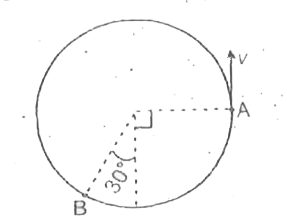A body revolves with constant speed v in a circular path of radius r. the magnitude of its average acceleration during motion between two points in diametrically opposite direction is
Zero
The correct Answer is:C
To find the magnitude of the average acceleration of a body moving with constant speed v in a circular path of radius r between two points that are diametrically opposite, we can follow these steps:
Step 1: Understand the motion
The body is in uniform circular motion, meaning it travels around a circular path with a constant speed. The points in question are diametrically opposite, which means they are on opposite ends of the diameter of the circle.
Step 2: Define initial and final velocities
Let’s denote the initial velocity vector when the body is at point A (let's say at the top of the circle) as:
→vi=v^j
And the final velocity vector when the body reaches point B (at the bottom of the circle) as:
→vf=−v^j
Step 3: Calculate the change in velocity
The change in velocity Δ→v can be calculated as:
Δ→v=→vf−→vi=(−v^j)−(v^j)=−2v^j
Step 4: Determine the time interval
The time taken to move from point A to point B is half the time period of the circular motion. The time period T for one complete revolution is given by:
T=2πrv
Thus, the time interval Δt for half a revolution is:
Δt=T2=2πr2v=πrv
Step 5: Calculate average acceleration
Average acceleration →aavg is defined as the change in velocity divided by the time interval:
→aavg=Δ→vΔt=−2v^jπrv=−2v2^jπr
Step 6: Find the magnitude of average acceleration
The magnitude of the average acceleration aavg is:
aavg=∣∣∣−2v2πr∣∣∣=2v2πr
Conclusion
Thus, the magnitude of the average acceleration during the motion between two diametrically opposite points is:
2v2πr
---
The body is in uniform circular motion, meaning it travels around a circular path with a constant speed. The points in question are diametrically opposite, which means they are on opposite ends of the diameter of the circle.
Let’s denote the initial velocity vector when the body is at point A (let's say at the top of the circle) as:
→vi=v^j
And the final velocity vector when the body reaches point B (at the bottom of the circle) as:
→vf=−v^j
The change in velocity Δ→v can be calculated as:
Δ→v=→vf−→vi=(−v^j)−(v^j)=−2v^j
The time taken to move from point A to point B is half the time period of the circular motion. The time period T for one complete revolution is given by:
T=2πrv
Thus, the time interval Δt for half a revolution is:
Δt=T2=2πr2v=πrv
Average acceleration →aavg is defined as the change in velocity divided by the time interval:
→aavg=Δ→vΔt=−2v^jπrv=−2v2^jπr
The magnitude of the average acceleration aavg is:
aavg=∣∣∣−2v2πr∣∣∣=2v2πr
Thus, the magnitude of the average acceleration during the motion between two diametrically opposite points is:
2v2πr
Similar Questions
A particle of mass m moves with constant speed v on a circular path of radius r. Find magnitude of average force on it in half revolution.
View SolutionA particle moves with constant speed v along a circular path of radius r and completes the circle in time T. The acceleration of the particle is
View Solution
Knowledge Check
A particle is moving on a circular path of radius R with constant speed v. During motion of the particle form point A to point B
 AAverage speed is v/2BThe magnitude of average velocity is v/πCThe magnitude of average acceleration is 2v2πRDAverage velocity is zero.
AAverage speed is v/2BThe magnitude of average velocity is v/πCThe magnitude of average acceleration is 2v2πRDAverage velocity is zero.
A particle of mass m moves with constant speed v on a circular path of radius r as shown in figure. The average force on it during its motion from A to B is

View SolutionAn object of mass 5 kg moves at a constant speed of 6 m/s in a circular path of radius 2m. Find the magnitude of the object's acceleration and the net force responsible for its motion.
View SolutionA particle of mass M moves with constant speed along a circular path of radius r under the action of a force F. Its speed is
View SolutionA particle is moving with speed v in a circle of radius R. Find the magnitude for average velocity of point
for the half revolution
View SolutionWhy is the motion of a body moving with a constant speed around a circular path said to be accelerated ?
View SolutionAn object of mass m moves with constant speed in a circular path of radius r under the action of a force of constant magnitude F. the kinetic energy of object is
View SolutionA body of mass 100 g is rotating in a circular path of radius r with constant speed. The work done in one complete revolution is
View Solution
